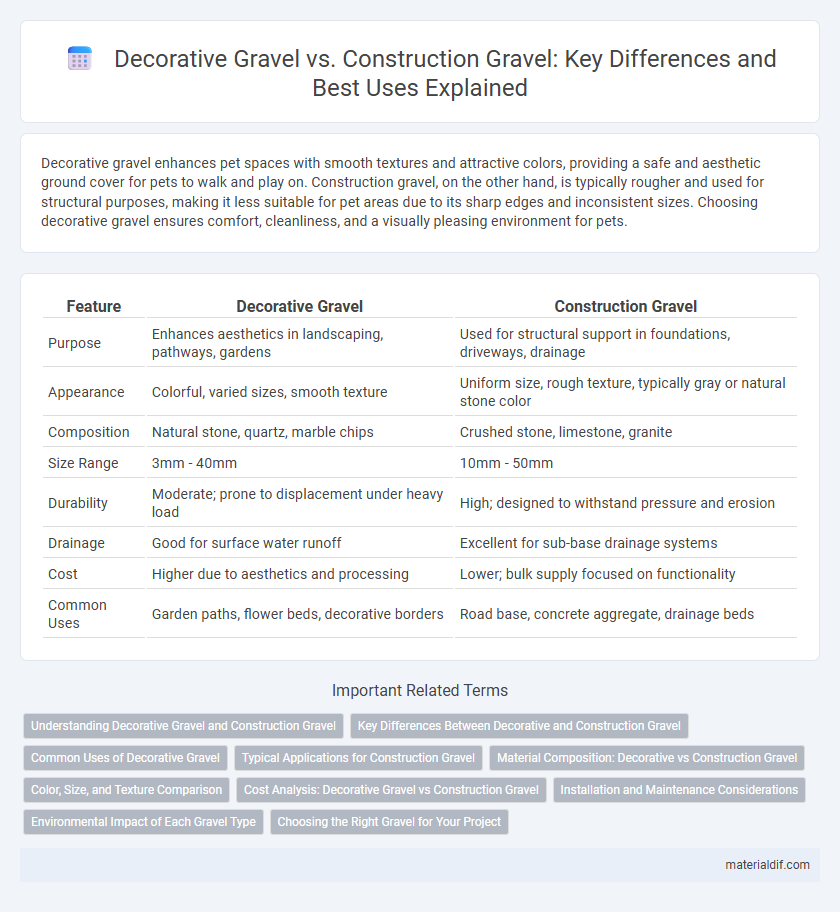Decorative gravel enhances pet spaces with smooth textures and attractive colors, providing a safe and aesthetic ground cover for pets to walk and play on. Construction gravel, on the other hand, is typically rougher and used for structural purposes, making it less suitable for pet areas due to its sharp edges and inconsistent sizes. Choosing decorative gravel ensures comfort, cleanliness, and a visually pleasing environment for pets.
Table of Comparison
| Feature | Decorative Gravel | Construction Gravel |
|---|---|---|
| Purpose | Enhances aesthetics in landscaping, pathways, gardens | Used for structural support in foundations, driveways, drainage |
| Appearance | Colorful, varied sizes, smooth texture | Uniform size, rough texture, typically gray or natural stone color |
| Composition | Natural stone, quartz, marble chips | Crushed stone, limestone, granite |
| Size Range | 3mm - 40mm | 10mm - 50mm |
| Durability | Moderate; prone to displacement under heavy load | High; designed to withstand pressure and erosion |
| Drainage | Good for surface water runoff | Excellent for sub-base drainage systems |
| Cost | Higher due to aesthetics and processing | Lower; bulk supply focused on functionality |
| Common Uses | Garden paths, flower beds, decorative borders | Road base, concrete aggregate, drainage beds |
Understanding Decorative Gravel and Construction Gravel
Decorative gravel is characterized by its aesthetic appeal, featuring smooth textures and vibrant colors that enhance landscaping and garden designs. Construction gravel consists of rough, angular stones primarily used for structural support in building foundations, roadways, and concrete mixtures. Understanding the differences between decorative and construction gravel is essential for selecting the right material based on project requirements, functionality, and visual preferences.
Key Differences Between Decorative and Construction Gravel
Decorative gravel features uniform shapes, smooth textures, and vibrant colors ideal for landscaping, pathways, and garden aesthetics, while construction gravel consists of irregular, angular stones used primarily for structural support in concrete, road base, and drainage systems. Decorative gravel typically ranges from 1/8 to 1 inch in size, enhancing visual appeal and surface stability, contrasting with the larger, more robust composition of construction gravel engineered for load-bearing capacity. The key differences lie in composition, purpose, and appearance, with decorative gravel emphasizing design and construction gravel focusing on durability and functionality.
Common Uses of Decorative Gravel
Decorative gravel is commonly used for landscaping projects such as garden pathways, flower beds, and around water features to enhance visual appeal and provide effective drainage. It is favored for its varied colors and smooth textures, making it ideal for patios, driveways, and accent areas where aesthetics matter. Unlike construction gravel, which is primarily used as a base or structural material, decorative gravel emphasizes design and surface appearance in outdoor spaces.
Typical Applications for Construction Gravel
Construction gravel is primarily used for foundational applications such as creating stable base layers for roads, driveways, and building foundations due to its strength and durability. It is also essential for drainage systems and concrete production, providing necessary support and filtration. Unlike decorative gravel, which enhances aesthetic appeal, construction gravel focuses on structural integrity and load-bearing capabilities in various engineering projects.
Material Composition: Decorative vs Construction Gravel
Decorative gravel typically consists of polished stones such as quartz, granite, or marble chips, chosen for their aesthetic appeal and variety of colors and textures. Construction gravel is usually composed of crushed limestone, granite, or trap rock, designed for strength and durability to support foundations, driveways, and drainage systems. The distinct material composition directly influences their suitability for ornamental landscaping versus structural applications.
Color, Size, and Texture Comparison
Decorative gravel features a wide range of vibrant colors, finer sizes, and smoother textures, enhancing aesthetic appeal for landscaping projects. Construction gravel typically consists of larger, irregularly shaped stones with muted colors like gray and beige, providing durability and stability for foundational use. The smoother texture and varied hues of decorative gravel distinguish it sharply from the coarse, utilitarian nature of construction gravel.
Cost Analysis: Decorative Gravel vs Construction Gravel
Decorative gravel typically costs between $50 to $150 per ton, reflecting its higher aesthetic value and variety of colors and shapes, while construction gravel ranges from $10 to $50 per ton, prioritizing functional use over appearance. Installation and maintenance expenses for decorative gravel are generally higher due to the need for weed barriers and frequent upkeep, whereas construction gravel requires less maintenance and simpler installation methods. Evaluating total project costs involves considering both initial material prices and long-term expenses, where decorative gravel suits landscaping projects, and construction gravel is more cost-effective for foundational and structural purposes.
Installation and Maintenance Considerations
Decorative gravel requires careful installation with a weed barrier and edging to maintain its aesthetic appeal and prevent migration, while construction gravel focuses on proper compaction and drainage for structural stability. Maintenance of decorative gravel involves regular raking and occasional replenishment to keep the surface level and attractive compared to construction gravel, which typically needs minimal upkeep once properly installed. Selecting the gravel type depends on the project's visual goals and the durability required for heavy use or load-bearing purposes.
Environmental Impact of Each Gravel Type
Decorative gravel typically has a lower environmental impact due to its smaller extraction footprint and often uses recycled materials, reducing waste and resource consumption. Construction gravel extraction can lead to significant habitat disruption and increased carbon emissions from heavy machinery and transportation. Proper sourcing and sustainable mining practices are essential to mitigate the environmental effects associated with both types of gravel.
Choosing the Right Gravel for Your Project
Decorative gravel features smooth textures and vibrant colors, making it ideal for landscaping, garden pathways, and aesthetic enhancements, while construction gravel consists of larger, angular stones designed for durability and load-bearing in foundations, driveways, and concrete mixes. Selecting the right gravel depends on the project's structural requirements and visual appeal, ensuring proper function and long-lasting results. Understanding these differences helps optimize material use, balancing performance with design needs for any outdoor project.
Decorative Gravel vs Construction Gravel Infographic

 materialdif.com
materialdif.com